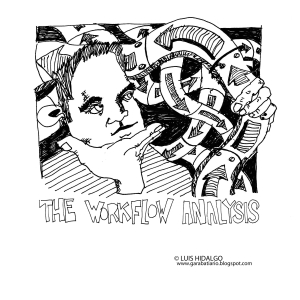The Workflow Analysis is a tool to document and enumerate the workflows around products and services of the company that are touched by end-users. The workflow analysis follows key workflows through the organization’s products and services entering, crossing boundaries, and exiting upon conclusion of the work. The workflows may occur across personas, departments, and organizations. An example of a workflow might be on-boarding a new customer. After the sale has been done and the contract signed, how do you get the customer set up with your system. Follow the workflow from the signed contract through until the customer is up and running. The point is to follow the trail and visualize how the workflow happens today.
Begin by mining what your company knows about the user. Start by interviewing people in each department. Have them describe how the users interact and what they think the user is trying to accomplish. Once you have interviewed people internally, you can now interview users to find out what they are trying to accomplish.
Both sets of interviews can be consolidated into a list of key workflows. A list of 10 to 15 workflows is enough to gain an understanding. More than 15 workflows would be too much.
I recommend taking these 10 to 15 workflows and prioritizing them according to your business and the stakeholders’ priorities. Be focused here so you are working on the highest priority workflows first. Take the top 3 to 5 and document them in detail. By the time you get through 3 to 5 workflows, you will learn a lot and your viewpoint will change significantly on the other 10.
Each workflow should be documented by showing all the tools, communication, and events that help the work move along. Visualize the workflow with a description or story of what is being done. Add pictures, sketches, and screenshots to show the interactions the user is having. Think broadly here. The tendency is to keep workflows too simple, keeping to limited tasks and departments, and not accurately capturing all the points of contact in a true end-to-end workflow.

As each workflow is documented, you will be able to see inefficiencies, duplication, areas that cause errors, and spots with unnecessary friction. Overlay these problems on the workflows so they are highlighted.
The purpose of the workflow analysis is to expose challenges that users encounter with the products and services. This process will help to pull the organization out of the “feature-focus” of product development. A Workflow Analysis a great tool to align people at all levels in the organization to focus everyone on the user getting work done.
Copyright 2015 Frictionless Design LLC

